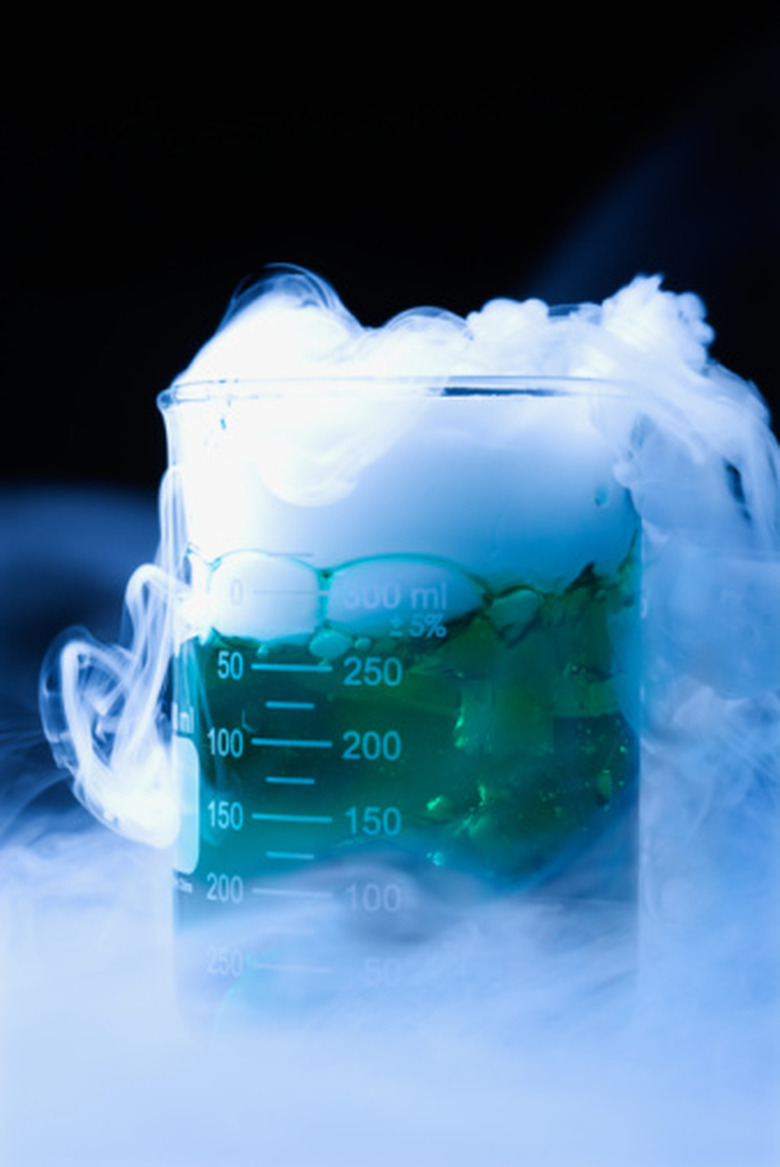Middle School Science Fair Projects With Dry Ice
Dry ice is frozen carbon dioxide. At -78.5 degrees Celsius, dry ice is colder than regular ice. Unlike water ice, dry ice goes from a solid to a gas without becoming a liquid in a process called sublimation. Making dry ice requires putting carbon dioxide under pressure while cooling the container. Normally, gases heat under pressure. Spraying the compressed gas produces a carbon dioxide snow. Pressing the CO2 snow into blocks creates dry ice. Be sure to wear thermal gloves when handling dry ice.
Volcano
Volcano
Make a volcano out of plaster or flour-based modeling dough. Place a metal cup in the center of the bottom layer of dough to prevent leaks from the bottom of the volcano. Shape the volcano around the cup, making crags and rocky outcrops. After the dough or plaster has hardened, fill the cup with hot water from a thermos and add a few squirts of dish soap and several drops of red, blue and yellow food coloring. Feed small chunks of dry ice down the volcano chimney. The dry-ice fog foam will spew from the top of the volcano and creep down the sides of the display.
Comets
Comets
Line a quart bowl with a black plastic bag. Pour two cups of water into the lined bowl. Add two tablespoons of sand and three drops of ammonia to the water in the bowl and stir. Fill a sandwich bag with dry ice and smash it with a hammer. Add two cups of crushed dry ice to the mixture in the bowl. Use the black plastic liner to shape the slush into a ball just before it completely freezes. Watch your dry ice comet sublime away. For a presentation, you can prepare several comet balls ahead of time and keep them frozen in a cooler. For your science fair project, make a poster board showing photos of real comets and explain what is taking place.
Floating Bubbles
Floating Bubbles
Put dry ice in a bowl and let it sublime. Once the bowl is full of carbon dioxide gas, dip a straw into the bubble solution and blow bubbles toward the bowl. The bubbles will float on the carbon dioxide gas because carbon dioxide is heavier than air. Draw a diagram on a poster board explaining sublimation and how your bubble trick works.
Balloons
Balloons
Crush some dry ice into dime-sized pieces. Spread the mouth of a balloon open with your fingers. Have someone help you by placing a piece of dry ice inside the balloon with tongs. Tie the balloon closed. The balloon will expand. After you are sure the frozen CO2 has all sublimed, hold the balloon near your ear and notice how much clearer you can hear distant and quiet conversations. Prepare a poster board explaining how the speed of sound in the air is affected by carbon dioxide.
Cite This Article
MLA
Rose, Kasandra. "Middle School Science Fair Projects With Dry Ice" sciencing.com, https://www.sciencing.com/middle-fair-projects-dry-ice-7999129/. 24 April 2017.
APA
Rose, Kasandra. (2017, April 24). Middle School Science Fair Projects With Dry Ice. sciencing.com. Retrieved from https://www.sciencing.com/middle-fair-projects-dry-ice-7999129/
Chicago
Rose, Kasandra. Middle School Science Fair Projects With Dry Ice last modified August 30, 2022. https://www.sciencing.com/middle-fair-projects-dry-ice-7999129/
